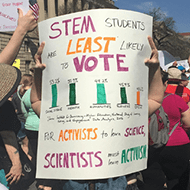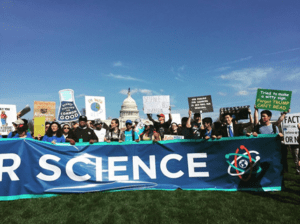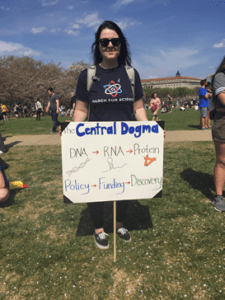Nascent Transcript Writer: Allison McCague
May 2018

Credit: Allison McCague
The second annual March for Science was held last month in Washington, DC, and many cities all around the world. The inaugural March for Science, held on a cold, rainy, and damp day, drew approximately 100,000 marchers to Washington in 2017, and over one million people participated in some sort of March for Science event worldwide, including big names such as Bill Nye the Science Guy.
Leading up to the 2017 March, the President’s newly released budget had proposed a 20% cut to the National Institutes of Health’s budget. The University of Delaware conducted a survey of members of the March for Science Facebook groups, asking about their motivations to march. The top reasons cited included “encouraging policies based on science,” “encouraging the public to support science,” “opposing political attacks on science,” and “protesting cuts in science funding.” These results painted a picture of the overall mood of the inaugural March: protecting science from what felt like a threat.
I attended the 2017 March for Science and made my way down to Washington, DC from Baltimore on April 14, 2018, for this year’s March. As I stepped onto the bright, sunlit sidewalk from the dark tunnel leading from the Metro and walked toward the Washington Monument, there were a lot of familiar sights at this year’s event: people in lab coats, nerdy signs, and lots of energy.
I noticed a lot of differences, too, other than the weather. The crowd was a lot smaller this year; the March for Science organizers estimate that approximately 10,000 people showed up to the Washington, DC, March this year, which is a tenfold decrease from last year’s event. It makes sense, as movements often suffer from a decline in energy as time goes on, and it is always difficult to keep up participation. The first March for Science represented unprecedented involvement of scientists in the public and political spheres.
There was also a distinct shift in tone from last year’s March to this year’s March. The 2018 omnibus spending bill passed by Congress gave an 8.8% funding increase to the National Institutes of Health. Graduate students’ fears over the “grad student tax” were assuaged. A literal and figurative cloud seemed to have been lifted—the threat that seemed so imminent one year ago did not feel as much so. There was a sense of optimism and hope that matched the warm, cloudless day.
This, of course, isn’t to say that participants found themselves at a loss for reasons to march. I conducted a survey of my own, admittedly less comprehensive than that of the University of Delaware last year, asking fellow trainees in my own community as well as at the March what motivated them to participate.
Vy Tran, a PhD student in the Department of Environmental Health and Engineering at the Johns Hopkins Bloomberg School of Public Health, and member of the Johns Hopkins Science Policy Group, told me in an email that she values public trust in science and diversity in the scientific community.

“I march because I believe that society’s trust in science is a worthy cause to fight for,” wrote Tran. “It is unfortunate that the trust in science by the public has been declining recently. I believe that as scientists, we are responsible for earning back this trust. I advocate more training in science communication, so that study findings are accurately and clearly explained to the media, policy makers, and the public. I also support more use of systematic reviews, which helps increase rigor and transparency in synthesizing scientific evidence. The March for Science is an inspiring event. But what matters even more is what each of us will do when we return to the lab to reaffirm people’s belief in evidence-based research.
I also march because I believe in the value of diversity in science. At Johns Hopkins, I work with colleagues from incredibly diverse backgrounds, and I am myself an immigrant. Just as the diversity of life is what makes it so charming and delightful, the contribution of scientists with different expertise and perspectives help provide new insights to scientific studies.”
Interestingly, these two precise themes—encouraging scientists to engage the public and encouraging diversity in science—were markedly lower on the list of priorities cited by the respondents in the University of Delaware survey from last year’s March. And yet, these were themes that were very forward in this year’s March. The lineup of speakers this year, which included individuals from a wide array of professional, racial, and socioeconomic backgrounds, reflected diversity as a priority for the March organizers.
Mari Copeny, better known as “Little Miss Flint,” was the 10-year-old star of the group, speaking passionately about the Flint water crisis. “The scariest thing is that Flint is not alone,” she said. “We need the government to listen to science.”
Evelyn Valdez-Ward, a PhD student at UC Irvine and a DREAMer, spoke about the challenges of trying to find graduate school opportunities, given her immigration status and the connection between science and immigration policy.
Dr. Henry “Hoby” Wedler spoke about the challenges he faces as a blind man conducting science and increasing the accessibility of science to all people.
Students and trainees at the March also emphasized public engagement in science. I met a group of Johns Hopkins seniors, all three of whom were pursuing PhDs upon graduation.
“I think a march like this is really great for empowering people who wouldn’t normally get into STEM to get into STEM,” said one of the students.
“Anyone can be a scientist. Just do it!” chimed in another.
I also spoke with Katie, a second-year PhD student in Environmental Health at the Johns Hopkins Bloomberg School of Public Health and laughed to myself at the coincidence of finding so many fellow students from Hopkins. I promise that this was not intentional and is likely regional bias, being a large research university located so close to the nation’s capital.
I asked Katie about why she thinks trainees being engaged in science advocacy is important. “I think that as the next wave of scientists, it’s important that trainees be involved and be outspoken,” Katie replied. “I’ve seen it with even high-schoolers getting involved. They’re going to be the ones taking these jobs in the next couple decades. So laying that foundation and having our generation put importance on advocacy, I think matters.”

Credit: Allison McCague
Another group of students I ran into included one from Penn State, three from the Johns Hopkins Molecular Microbiology and Immunology program, and one from Peru.
“[Science] is very interdisciplinary,” said one of the MMI students when prompted about their motivation to march. “And it affects almost everything that we do. So it would be nice for people to realize the importance of not just doing experiments; it’s really learning to problem-solve. You need that skill for everything.”
“It’s great to have a turnout,” chimed in another from the group. “But [we should be] actually following up and contacting your representatives and making sure that some change does come from this and it’s not just for show.”
“I would say even just getting more scientists into politics,” added another student.
When asked about the importance of trainees being involved in advocacy, one of the students replied, “I think scientists need to learn how to communicate. So just getting that exposure and starting there.”
“There’s a big divide between non-scientists and scientists,” another in the group agreed. “Scientific articles should be at a level where an average person could read it and understand it.”
“We need trainees and young people to know that science communication is a career path because I didn’t,” added Grace, the Penn State student. “Going into grad school, I didn’t know.”
There was a distinct emphasis among the groups of trainees I spoke to on bridging the gap between scientists and the public—making science more accessible to everyone. This, to me, was a recognizable and potent paradigm shift from last year’s March, where the focus was on protecting science funding and pushing back against a perceived lack of support for science in the government and a slipping trust of scientists.
This time around, the outlook was more optimistic. For some, even simply coming together as a scientific community was motivation enough.
“Part of it is the morale boosting,” Katie admitted when prompted about what she would like to see come out of the March for Science. Citing the isolation often felt by graduate students, she said, “I think it’s more like a reminder that you’re not alone. It feels that way so much sometimes, looking at the news, like, ‘Why am I doing this?’” Gatherings like the March for Science give scientists a chance to come together as a community, pushing back against the stereotype of the scientist holed up alone in his or her lab late at night furiously conducting experiments. “There’s a force here. There’s a movement here,” said Katie. “And there are people that care. And there are people that are going to fight back. And I think that’s really powerful.”
It is powerful. Even with reduced numbers compared to last year, I felt it. There is something to be said for spending a day with a community of people who care about the same things that you do and speaking up for those things. It was a day well spent.
